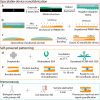Three-Dimensional Microfluidic Capillary Device for Rapid and Multiplexed Immunoassays in Whole Blood
- PMID: 38687557
- PMCID: PMC11129352
- DOI: 10.1021/acssensors.4c00153
Three-Dimensional Microfluidic Capillary Device for Rapid and Multiplexed Immunoassays in Whole Blood
Abstract
In this study, we demonstrate whole blood immunoassays using a microfluidic device optimized for conducting rapid and multiplexed fluorescence-linked immunoassays. The device is capable of handling whole blood samples without any preparatory treatment. The three-dimensional channels in poly(methyl methacrylate) are designed to passively load bodily fluids and, due to their linearly tapered profile, facilitate size-dependent immobilization of biofunctionalized particles. The channel geometry is optimized to allow for the unimpeded flow of cellular constituents such as red blood cells (RBCs). Additionally, to make the device easier to operate, the biofunctionalized particles are pretrapped in a first step, and the channel is dried under vacuum, after which it can be loaded with the biological sample. This novel approach and design eliminated the need for traditionally laborious steps such as filtering, incubation, and washing steps, thereby substantially simplifying the immunoassay procedures. Moreover, by leveraging the shallow device dimensions, we show that sample loading to read-out is possible within 5 min. Our results also show that the presence of RBCs does not compromise the sensitivity of the assays when compared to those performed in a pure buffer solution. This highlights the practical adaptability of the device for simple and rapid whole-blood assays. Lastly, we demonstrate the device's multiplexing capability by pretrapping particles of different sizes, each functionalized with a different antigen, thus enabling the performance of multiplexed on-chip whole-blood immunoassays, showcasing the device's versatility and effectiveness toward low-cost, simple, and multiplexed sensing of biomarkers and pathogens directly in whole blood.
Keywords: blood; diagnostics; immunosensors; microfluidics; multiplexing.
Conflict of interest statement
The authors declare the following competing financial interest(s): The authors declare the following competing interests: EP21171944 and EP2022P04672.
Figures








References
-
- Pinho A. R.; Fortuna A.; Falcão A.; Santos A. C.; Seiça R.; Estevens C.; Veiga F.; Ribeiro A. J. Comparison of ELISA and HPLC-MS Methods for the Determination of Exenatide in Biological and Biotechnology-Based Formulation Matrices. J. Pharm. Anal. 2019, 9 (3), 143–155. 10.1016/j.jpha.2019.02.001. - DOI - PMC - PubMed
Publication types
MeSH terms
Substances
LinkOut - more resources
Full Text Sources

